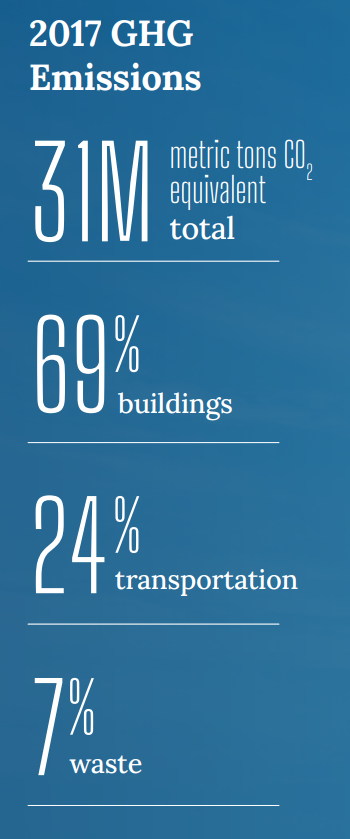Electrify Chicago
An independent tool for viewing City of Chicago building data
According to the
2022 Chicago Climate Action Plan,
69% of Chicago's emissions come from buildings, making
building emissions our biggest challenge and our biggest opportunity as a city
to tackle climate change. At Electrify Chicago, we showcase building performance using
publicly available data supplemented by community-submitted photographs and building
owners.
Start by looking at Chicago's buildings with the highest greenhouse gas intensity i.e. emissions per square foot. Large, efficient, buildings can perform much better than very inefficient small buildings on this metric.
New Article
📰 $30 Million In Missed Fines
The City Of Chicago failed to collect $30 million in potential fines from the building benchmarking ordinance, reducing transparency and accountability.
Legislative update! 🎉
As of late January 2024, legislation is being introduced to require new use more efficient forms of water and space heating, via the Clean And Affordable Buildings Ordinance (CABO), which will reduce the number of highly polluting and inefficient buildings that end up on this site.
If you're in Chicago,
write to your alderman to support the CABO!
Chicago Buildings by Greenhouse Gas Intensity
Note: Data includes large Chicago buildings with data from 2022, unless explicitly stated otherwise.
Note: This data only includes buildings whose emissions are reported
under the
Chicago Energy Benchmarking Ordinance. According to the City “As of 2016,
this list includes all commercial, institutional, and residential buildings larger than
50,000 square feet.” This dataset is also then filtered to only buildings with
reported emissions > 1,000 metric tons CO2 equivalent.
The latest year of data is from 2022, but we update the site regularly when new data is available, and some buildings may have failed to report that year, and only have older data available.
| Property Name / address | Primary Property Type |
Greenhouse Gas Intensity (kg CO2 eq./sqft) |
Total Greenhouse Emissions (metric tons CO2 eq.) |
|---|---|---|---|
|
Prosser Career Acad HS -CPS
(CPS)
2148 N Long Ave
| K-12 School | 10.7 kg/sqft
Highest 11%
| 2,238 tons
Highest 20%
|
|
310 S PEORIA ST
310 S PEORIA ST
| Multifamily Housing | 10.7 kg/sqft
Highest 11%
| 2,015 tons
Highest 23%
|
|
(ILCH720) - Burnham Pointe [external]
🕰️
720 S. Clark Street
| Multifamily Housing | 10.7 kg/sqft | 4,105 tons |
|
2303 N CLYBOURN AVE
2303 N CLYBOURN AVE
| Multifamily Housing | 10.7 kg/sqft
Highest 11%
| 1,514 tons
Highest 31%
|
|
60 W ERIE ST
60 W ERIE ST
| Multifamily Housing | 10.7 kg/sqft
Highest 11%
| 736 tons
Lowest 42%
|
|
600 W Chicago
🚨
600 W Chicago
| Office | 10.7 kg/sqft
Highest 11%
| 24,266 tons #8 Highest
|
|
The Jeffery Cyril Building
🕰️
7144-48 S Jeffery Blvd
| Multifamily Housing | 10.7 kg/sqft | 604 tons |
|
430 W. Erie
🕰️
430 W Erie St
| Office | 10.6 kg/sqft | 730 tons |
|
Palmer House Office Center - Thor Equities
🕰️
27 E Monroe St
| Office | 10.6 kg/sqft | 646 tons |
|
Smith -CPS
🕰️
(CPS)
730 E 103rd St
| K-12 School | 10.6 kg/sqft | 814 tons |
|
1165 N Clark St
1165 N Clark St
| Office | 10.6 kg/sqft
Highest 11%
| 1,084 tons
Highest 42%
|
|
American Library Association
🕰️
40-50 E. Huron
| Office | 10.6 kg/sqft | 1,105 tons |
|
#1976 Lincoln Park
2647 2679 N Halsted St
| Retail Store | 10.6 kg/sqft
Highest 11%
| 853 tons
Lowest 49%
|
|
AMA Plaza
🚩
330 N Wabash Av
| Office | 10.6 kg/sqft
Highest 11%
| 19,786 tons #13 Highest
|
|
North Park University
5148 N KEDZIE AVE
| College/University | 10.6 kg/sqft
Highest 11%
| 1,203 tons
Highest 39%
|
Data Source:
Chicago Energy Benchmarking Data
